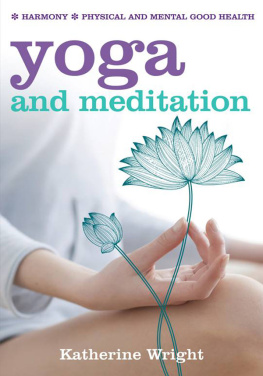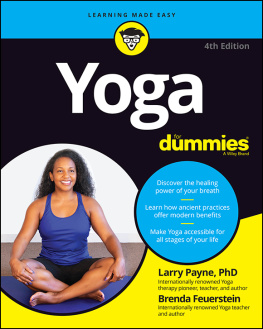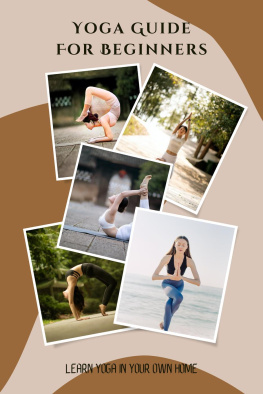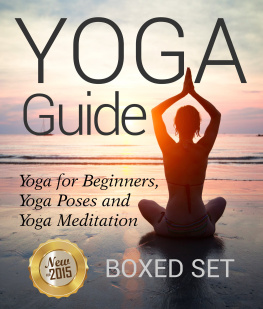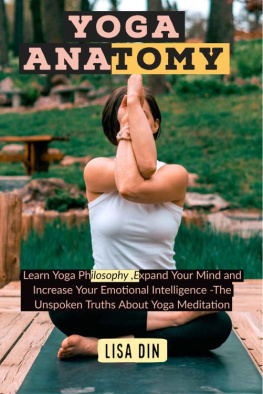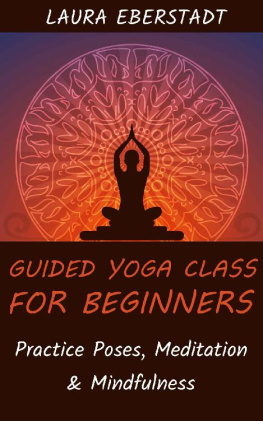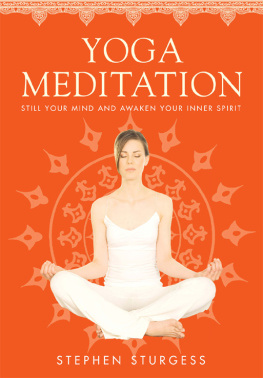Katherine Wright - Yoga and Meditation: Harmony; Physical and Mental Good Health
Here you can read online Katherine Wright - Yoga and Meditation: Harmony; Physical and Mental Good Health full text of the book (entire story) in english for free. Download pdf and epub, get meaning, cover and reviews about this ebook. year: 2015, publisher: Waverley Books, genre: Religion. Description of the work, (preface) as well as reviews are available. Best literature library LitArk.com created for fans of good reading and offers a wide selection of genres:
Romance novel
Science fiction
Adventure
Detective
Science
History
Home and family
Prose
Art
Politics
Computer
Non-fiction
Religion
Business
Children
Humor
Choose a favorite category and find really read worthwhile books. Enjoy immersion in the world of imagination, feel the emotions of the characters or learn something new for yourself, make an fascinating discovery.
- Book:Yoga and Meditation: Harmony; Physical and Mental Good Health
- Author:
- Publisher:Waverley Books
- Genre:
- Year:2015
- Rating:4 / 5
- Favourites:Add to favourites
- Your mark:
- 80
- 1
- 2
- 3
- 4
- 5
Yoga and Meditation: Harmony; Physical and Mental Good Health: summary, description and annotation
We offer to read an annotation, description, summary or preface (depends on what the author of the book "Yoga and Meditation: Harmony; Physical and Mental Good Health" wrote himself). If you haven't found the necessary information about the book — write in the comments, we will try to find it.
An introducition to yoga and meditation techniques
Yoga and Meditation: Harmony; Physical and Mental Good Health — read online for free the complete book (whole text) full work
Below is the text of the book, divided by pages. System saving the place of the last page read, allows you to conveniently read the book "Yoga and Meditation: Harmony; Physical and Mental Good Health" online for free, without having to search again every time where you left off. Put a bookmark, and you can go to the page where you finished reading at any time.
Font size:
Interval:
Bookmark:


Published 2015 by Geddes & Grosset,
an imprint of The Gresham Publishing Company Ltd,
Academy Park, Building 4000, Gower Street,
Glasgow, G51 1PR, Scotland
Copyright 2015 The Gresham Publishing Company
All rights reserved. No part of this publication may be reproduced, stored in a retrieval system or transmitted in any form or by any means, electronic, mechanical, photocopying, recording or otherwise, without the prior permission of the copyright holder.
ISBN 978-1-910680-02-5
CHAPTER 1
Introduction
A stressful world
In recent years, developments in science, technology and industry have accelerated. So have trends, and every season we are under pressure to dress in the latest style, to change our hairstyles, our eating habits, even where we put the furniture. Thousands of new book titles appear every year, challenging us to be well read and up to date, while dozens of TV channels and radio stations vie for our attention and subscription. Coupled with this is the fact that few of us have only a job to worry about, or children, or the household, or our health. Most of us are juggling several of these at one time, as well as trying to keep up with all the changes around us. Further, almost all of us struggle to be everything to all people: caring parent, fun-loving but sympathetic friend, dutiful child, and efficient employee.
While our minds reel with all these demands, our bodies develop tension headaches and muscular pains. We cant get to sleep at night, we drink and smoke too much, our relationships falter, our self-esteem plummets and our health suffers. Our world is undoubtedly a very stressful place, but learning to cope with stress is not the impossible task it may at first seem. What we have to learn is that our usual reactions to stress, such as drinking more heavily or pushing ourselves harder at work, are only making it worse. Physical exercise and relaxation go some way to redressing the balance, but our minds also require attention. After all, relaxed and happy people are healthier than stressed and miserable ones.
We have to learn how to take a step back, clear our heads, take a deep breath, and just be. If, for just a few minutes every day, everyone in the world did that, there would be considerably less heartache and strife.
Towards contentment
In the words of the philosopher, Ludwig Wittgenstein, The world of those who are happy is different from the world of those who are not. Meditation is the art of transcending our everyday thought processes and world view, if only for a very short period of time every other day. Our minds briefly escape the tyranny of worry and self-image, and we begin to get a sense of who we truly are and what we truly feel. If practised regularly, meditation will enhance our feelings of self-worth, and inevitably this will be reflected in the way we see the world. In short, by learning to like ourselves, we will also learn to like the world.
Meditation has physical benefits too. By enabling us to access inner calm, it helps us to alleviate stress, which is being linked to more and more physical ailments, from migraine to high blood pressure to heart and lung conditions. Meditation has also shown itself to be effective in the battle against addiction to alcohol and cigarettes.
Buddhism holds meditation at the heart of its practice, as do the other great oriental religions, such as Hinduism, whose most influential book, Bhagavad Gita, devotes an entire section to the practice of meditation and Sufism. In religious meditation, the sense of self-worth is linked to a feeling of being closer to God. Meditation also has its place in Western religions, such as Christianity and Judaism, but it does not require adherence to a particular faith to be successful.
Many people view meditation as peaceful but ineffectual self-centredness in the words of one cynic, a form of self-indulgent, passive introversion. They are wrong the benefits to be gained from meditation in any of its various forms are many. Those who meditate regularly believe that it leads to a significant lowering of tension and negative emotions, while at the same time increasing efficiency at work and deepening the sense of inner calm.
This feeling of wellbeing brings physical benefits, for regular meditation eliminates or reduces stress, and who in the helter-skelter days of the beginning of the twenty-first century does not experience stress at some time or other? In reducing stress, meditation can ease migraine and tension headaches, reduce blood pressure, benefit the heart and reduce the discomfort of menstrual cramps.
What is meditation?
In its simplest form, meditation is nothing more than allowing the mind to be lulled by a simple repetitive sensation waves lapping on the beach, the tinkling of water from a fountain, repeating a word or sound over and over again, even something as mundane as the sound of machinery. Any of these, and countless others, can be used as something on which the mind focuses itself completely, thus putting worry and anxiety on the back-burner for a while. We have all done this naturally at some time or another: you may have gazed into a beautiful sunset and become absorbed in the flames of colour, or been seduced by the lapping of waves on the sea-shore and the heat from the sun, or even simply closed your eyes and savoured the taste of a delicious meal. Children are much better at this than adults. Think of a child, bent over a half-finished painting, and think of the number of times he or she has to be called before they hear you telling them that their lunch is ready? The child is not ignoring you, he or she is simply too wrapped up in what they are doing to be distracted by anyone or anything.
Put simply, meditation is me-time in its purest form: it is just being and letting the world around you just be as well. Used in a religious context, meditation is a means of communing directly with God, of focusing completely on him, and of seeing the world without the blinkers of selfish, worldly thought.
Meditation need not be a time-consuming process (twenty minutes a day are all that is needed). Practised properly, it is a voyage during which preconceived notions and ideas fade, the senses and the intellect are refined, and the ability to concentrate is increased.
Its benefits quickly become apparent, and those who practise it often say that the day they first took to meditation on a regular basis was a watershed in their lives.
What meditation is not:
Self-hypnosis
Which requires the participant to reach a state of semiconscious trance. Meditation is very much about the here and now and its aim is to enable the meditator to live in the moment.
Relaxation
Which is essentially passive, whereas meditation is an active focusing of the mind. While meditation attempts to transcend the normal thought processes, relaxation will often engage those very patterns of thought. However, meditation can be a great aid to relaxation, and relaxation a great aid to meditation.
Necessarily tied to a religion
Although meditation is used in all world religions, it does not specifically belong to any one nor is there any need for it to be tied to religion at all. Meditation can prove just as positive and spiritual an experience for an atheist as for a Buddhist.
Concentration
Which can be a means of achieving transcendence, but is not the object of the exercise. Concentrating on one thing is only a means to clearing the mind of all other thoughts. The object of your concentration is not important in itself, and, in fact, many meditators choose deliberately meaningless words or objects on which to concentrate for this very reason.
Font size:
Interval:
Bookmark:
Similar books «Yoga and Meditation: Harmony; Physical and Mental Good Health»
Look at similar books to Yoga and Meditation: Harmony; Physical and Mental Good Health. We have selected literature similar in name and meaning in the hope of providing readers with more options to find new, interesting, not yet read works.
Discussion, reviews of the book Yoga and Meditation: Harmony; Physical and Mental Good Health and just readers' own opinions. Leave your comments, write what you think about the work, its meaning or the main characters. Specify what exactly you liked and what you didn't like, and why you think so.

